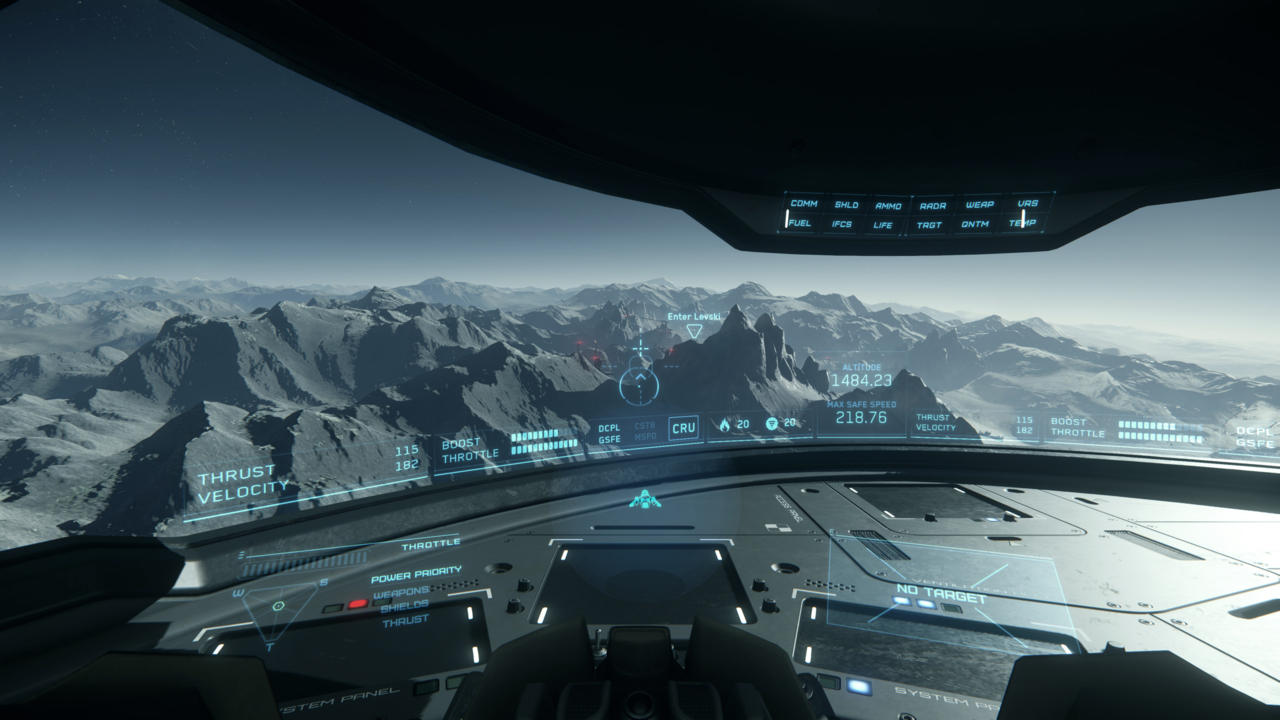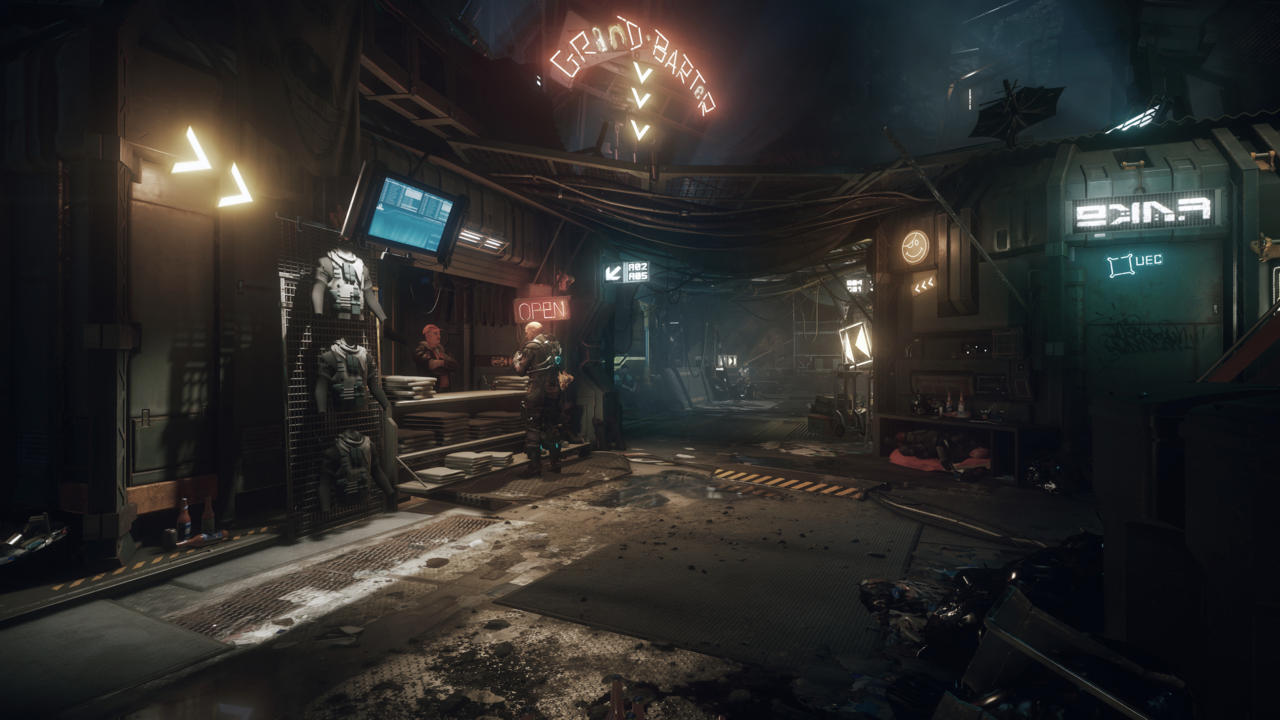The problem lies in a glass of booze. The mercenary across the table glances around the bar, then back at us, and tinkers with his wrist-mounted computer device--but he can't seem to grip his glass of pink alcohol. Our co-op partners are millions of miles away in another solar system. They're fighting pirates and careening through a foreign planet's atmosphere. But here, in this bar, at a lonely outpost on planet Delmar, that solitary glitch in the booze is a problem.
"We should have that fixed by tomorrow," Cloud Imperium Games founder Chris Roberts says. "Minor detail, but we should have it fixed."
To some, this meticulous attention to detail might seem excessive. But to Roberts, it's a necessity. It demonstrates Star Citizen's core tenet: the small things are important, even in a massive open world.
Roberts is at Gamescom showing off Update 3.0, the next expansion to Star Citizen, a massive MMO that hopes to combine first-person shooting, dog fighting, piracy, economic trading, and now, interstellar travel. Like Elite: Dangerous and the more recent No Man's Sky, Star Citizen is trying to build a seamless world on myriad planets and the space between them. If all goes according to plan, the bug he just saw will be squashed before his team livestreams the update on August 19--tomorrow night.

"We want to create texture--an emotional feeling for each location," Roberts says. "We need a history, a sense of place, for each of these worlds. Details are important."
Roberts' Gamescom demo begins in several places: a bed aboard a space station; a ship in the docking bay several floors below; an outpost waylaid by pirates on a distant planet under a star-spattered sky. For one Cloud Imperium member, the moment is tranquil. For her partners, it's chaos. One plays a first-person shooter, the next experiences a flight simulator, the next wanders around a hub town much like he might in a role-playing game.
In real life, they're sitting in a room together. But in Star Citizen, they're light years apart, playing cooperatively nonetheless.
So, they decide to meet up. The first player--we'll call him the Freelancer--consults his smart watch, sifting through various side quests and potential storylines to find a suitable job. And there it is: a mercenary on the space station Levski needs cargo delivered through means of questionable legality. The freelancer agrees to the task and makes for Port Alasar's docking bay.
We need a history, a sense of place for each of these worlds. Details are important.
Chris Roberts, Cloud Imperium founder
Here he finds the second player: a friend we'll call the Pilot. He has a two-person ship waiting in the hangar to take the duo to another system. They board the ship, leave their current station, and enter the vacuum of space. The pilot plots a course on his star map. He triggers the quantum drive. They leap forward at a speed faster than light toward the planet Delmar and the promise of payment for a job well done.
"We're actually moving in this space," Roberts says, eyes darting between each of the players' respective screens. "These aren't in-game warps disguised by animations. We're not cheating here."
Soon enough, the two arrive at Delmar and land in Levski's docking bay. The Pilot stays with the ship. The Freelancer heads for the saloon. There he finds the mercenary--the one who can't grip his glass--and learns the location of the "lost" cargo. In the courtyard outside the bar, the Freelancer pauses to examine his surroundings. Several people mill about the statue of a fallen hero. "Remember Antony Tanaka," a plaque reads. It's like Roberts said: "A history, a sense of place." A ship enters the Freelancer's line of sight through the window behind the statue. It seems the Pilot grew restless and needed time for a joyride.
Meanwhile, the other two players--we'll call them the Pioneers--are on a barren planet scarred by rocky gorges. They're firing assault rifle rounds into the open doorway of a pirate hideout. They can't see their enemies, but a crosshair indicator reassures them they're hitting something.

This planet is one of thousands that Cloud Imperium is creating. While No Man's Sky uses its tech to generate new planets as you travel, Star Citizen uses procedural generation to build the skeleton of specific planets before artists fill in the vital details. There are far fewer planets in Star Citizen--the studio is aiming for about 100 solar systems, each containing an average of five planets with their own moons as well--but Roberts and his team are working to ensure that each planet is worth exploring and returning to.
Despite No Man's Sky's technical achievements and gargantuan size (around 18 quintillion planets), detractors point to its lack of memorable moments as its chief downfall. With Star Citizen, Roberts says there will be side quests, distinct landmarks, new characters, and more to find on each rock's surface. Cloud Imperium is also aiming for "Crysis-like visual fidelity" on each one.
"No Man's Sky does a really cool thing with its planet-building tech, and it uses it well," Roberts says. "But the coolest thing it does, to me, is that seamless transition between the planet and space. We're aiming for that seamlessness, too. Once you exit the atmosphere, we want you already thinking about where you'll head next."
The firefight with the pirates continues for a few minutes. Then, as the Pioneers prepare to enter the structure, they look to the night sky. And there they are: the Freelancer and the Pilot, hurtling through the planet's atmosphere, straight toward the pirate stronghold. All of a sudden, a small speck emerges from the rear of the ship--it would seem the Freelancer found a hoverbike at Levski and wanted to try it out.
Once you exit a planet's atmosphere, we want you already thinking about where you'll head next.
Chris Roberts, Cloud Imperium founder
"We got in a dogfight with pirates on the way down," the Pilot tells his friends. Roberts saw it, too: it was like the turret scene from Star Wars. His eyes darted between the players' screens as the Freelancer manned the turret and the Pilot fired his forward-mounted cannons. They dispatched of the pirates and rushed to their co-op partners' aid.
As a newly formed team, the Freelancer and the Pioneers enter the complex, secure the cargo, load it aboard the Pilot's ship, and receive their payment through their respective wrist-mounted computers. Two of them travelled millions of actual in-game miles to get here. Two of them spent their time aiming down assault-rifle sights, killing pirates whose cohorts ambush any ship bold enough to enter this planet's orbit. This was a cooperative quest played across a span of light years, on planets that players will not just discover, Roberts says, but also remember when Update 3.0 launches later this year.
However, considering Star Citizen is a work-in-progress driven by constant crowdfunding, it's hard to tell when and if these claims will come to fruition.
"Exploring on its own can be great," he says, finally taking his eyes off the four screens surrounding him. "But we're trying to create something else. Something human in you needs something more to connect to. That's what we're looking for."
Now if only he could figure out the problem with that mercenary's drink.

